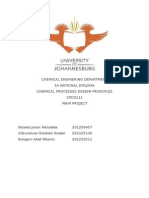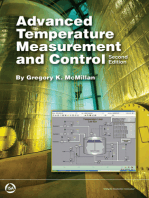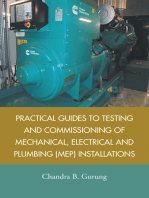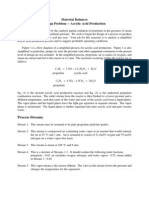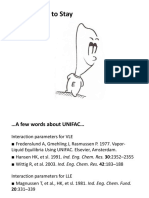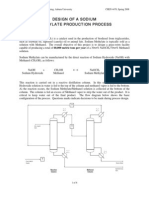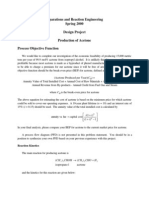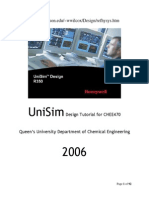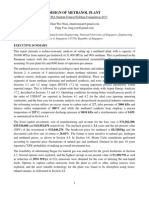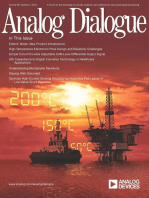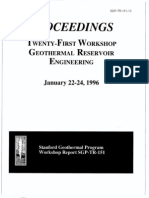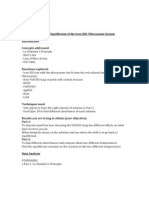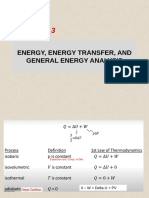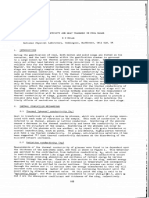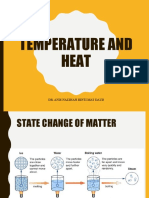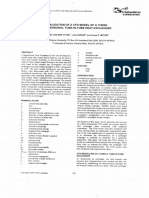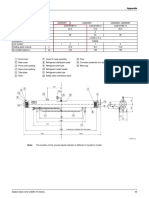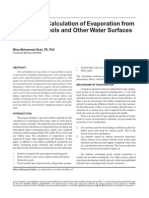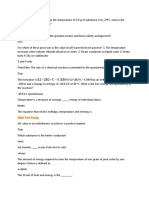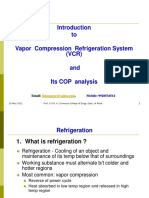Che 456 Spring 2007 Major 2 Production of Formalin: Background
Che 456 Spring 2007 Major 2 Production of Formalin: Background
Uploaded by
Josselyn VilcaCopyright:
Available Formats
Che 456 Spring 2007 Major 2 Production of Formalin: Background
Che 456 Spring 2007 Major 2 Production of Formalin: Background
Uploaded by
Josselyn VilcaOriginal Title
Copyright
Available Formats
Share this document
Did you find this document useful?
Is this content inappropriate?
Copyright:
Available Formats
Che 456 Spring 2007 Major 2 Production of Formalin: Background
Che 456 Spring 2007 Major 2 Production of Formalin: Background
Uploaded by
Josselyn VilcaCopyright:
Available Formats
ChE 456
Spring 2007
Major 2
Production of Formalin
Background
Your job is to prepare a preliminary design for the new 50,000 tonne/y formalin from
methanol plant. The new plant will be integrated with a wood-products facility, so it will not be
necessary to have a large storage tank at the end of the process, since, under normal conditions, the
formalin will be fed directly to the resin production portion of the wood products facility. An
emergency storage tank, with appropriate controls, sized for a three-day supply of formalin is
suggested; but, under normal operating conditions, formalin product should not pass through this
tank.
A new catalyst has been identified that will simplify the reactor design and operation. This is
an oxide catalyst that has approximately uniform activity over a one-year period and catalyzes the
oxidation reaction but not the disproportionation reaction:
CH OH O HCHO H O
3
1
2
2 2
+ + (1)
The appropriate reactor design is a key consideration. It is believed that that a shell-and-tube
configuration with heat removal or staged adiabatic packed beds with intercooling would be two
good initial choices. This reaction operates at "methanol lean" conditions, i.e., below the LFL of
methanol of 6 mole%. Typical operating conditions for maximum catalyst activity are 200C to
350C, and pressures just above atmospheric.
This plant will be constructed in an area subject to seasonal fluctuations in ambient
temperature. As such, the temperature of available cooling water is expected to vary between
25C and 35C over the course of a year.
Assignment
Your assignment is to provide:
1. an optimized design of a plant to make formalin from methanol using the oxide catalyst
2. a clear operating policy for key pieces of equipment affected by the seasonal cooling
water variation
3. an economic evaluation (after-tax DCFROR, marginal tax rate assumed to be 40%, 5-
year MACRS) of the process, with a recommendation as to whether to construct the
plant. Assume that the desired, after-tax rate of return is 9% over 10 years, with a two-
year construction period. Capital costs are 60% at the end of year 1 and 40% at the end
2
of year 2. The land is already owned, there is no salvage value, and working capital is
50% of the first-years operating costs (including raw materials).
Report Format
This report should be comprehensive and should conform to the guidelines. It should be
bound in a folder that is not oversized relative to the number of pages in the report. Figures and
tables should be included as appropriate. An appendix should be attached that includes items such
as Chemcad output and sample calculations. These calculations should be easy to follow. The
confidentiality statement should be the very last page of the report.
The written report is a very important part of the assignment. Reports that do not conform to
the guidelines will receive severe deductions and will have to be rewritten to receive credit.
Poorly written and/or organized written reports may also require re-writing. Be sure to follow the
format outlined in the guidelines for written reports.
The following information, at a minimum, must appear in the main body of the final report:
1. a computer-generated PFD (not a Chemcad PFD) for the recommended optimum case,
2. a stream table containing the usual items,
3. a list of new equipment for the process, including bare module and installed costs, plus
equipment specifications (presented with a reasonable number of significant figures),
4. a summary table of all utilities used,
5. a clear summary of alternatives considered and a discussion, supported with figures, of
why the chosen alternative is superior,
6. a clear economic analysis which justifies the recommended case
7. a clear discussion of the operating policies for seasonal operation
8. a Chemcad report only for your optimized case (in the Appendix). This must contain the
equipment connectivity thermodynamics, and overall material balance cover pages, stream
flows, equipment summaries, tower profiles, and tray design specifications (if you use
Chemcad to design the trays). It should not contain stream properties. Missing Chemcad
output will not be requested; credit will be deducted as if the information is missing.
Oral Presentation
You will be expected to present and defend your results some time between February 19, 2007
and February 23, 2007. Your presentation should be 15-20 minutes, followed by about a 30
minute question and answer period. Make certain that you prepare for this presentation since it is
an important part of your assignment. You should bring at least one hard copy of your slides to
the presentation and hand it out before beginning the presentation.
3
Other Rules
You may not discuss this major with anyone other than the instructors. Discussion,
collaboration, or any other interaction with anyone other than the instructors is prohibited.
Violators will be subject to the penalties and procedures outlined in the University Procedures for
Handling Academic Dishonesty Cases (http://www.arc.wvu.edu/rightsa.html)
Consulting is available from the instructors. Chemcad consulting, i.e., questions on how to use
Chemcad, not how to interpret results, is unlimited and free, but only from the instructors. Each
individual may receive five free minutes of consulting from the instructors. After five minutes of
consulting, the rate is 2.5 points deducted for 15 minutes or any fraction of 15 minutes, on a
cumulative basis. The initial 15-minute period includes the 5 minutes of free consulting.
Late Reports
Late reports are unacceptable. The following severe penalties will apply:
late report on due date before noon: one letter grade (10 points)
late report after noon on due date: two letter grades (20 points)
late report one day late: three letter grades (30 points)
each additional day late: 10 additional points per day
4
Appendix 1
Reaction Kinetics
The reaction engineering group has obtained the following kinetic information on the
methanol oxidation reaction.
CH OH O HCHO H O
3
1
2
2 2
+ + (2)
The rate expression is
+
r
m
mole g catalyst hr =
k p
m
k p
m
[ / ]
1
1
2
(3)
where p is a partial pressure in atm, and m refers to methanol. The rate expression in Eq. (2) is
only valid when oxygen is present in excess. The catalyst bulk density is 1500 kg catalyst/m
3
of
reactor volume. The constants in Eq. (2) are defined as
T
k
8774
50 . 12
1
ln = (4)
T
k
7439
29 . 17
2
ln + = (5)
where T is in Kelvin.
5
Appendix 2
Chemcad Hints
Solutions of formaldehyde and water are very non-ideal. Individually, the volatilities are, from
most volatile to least volatile, formaldehyde, methanol, water. However, formaldehyde associates
with water so that when this three-component mixture is distilled, methanol is the light key and
water is the heavy key. The formaldehyde will follow the water. The ESDK K-value package
in Chemcad simulates this appropriately. Latent heat should be used for enthalpy calculations.
The expert system will recommend these choices.
When simulating an entire process, we recommend using the shortcut distillation column,
within the process for the methanol-water/formaldehyde distillation. SCDS or TOWR should then
be used as a separate item to simulate the column based on the results obtained from the shortcut
column.
For the reactor, you must set the local units within the kinetic reactor calculation to correspond
to the units of the chemical reaction. Remember that Chemcad only accepts rate data on a per
volume of reactor basis. You may choose any activation energy unit. Then, you must multiply
the numerator of the second term in Equations 4 and 5 by that value, since the reaction expression
for Chemcad assumes the form exp[-E/RT].
Since the reactor effluent to be purified will have non-condensable gases, some of them will
partition into the liquid phase in any initial separation. If these are included in a distillation
column feed, the simulation algorithm in Chemcad will try to condense them, and the top
temperature may appear inappropriately low. Therefore, to avoid this situation, a component
separator should be placed in the simulation just before the distillation column to remove all of the
non-condensable gases. In the simulation, this stream should be mixed with the off-gas stream.
However, in the actual process, these gases would be removed from a partial-total condenser at
the top of the distillation column. The non-condensable gases are vented off (the partial
component), while all components involved in the separation are condensed completely (the
total component). This should be appropriately illustrated on your PFD, with the non-
condensable gases mixing with the off-gas stream.
6
Appendix 3
Other Information
1. Assume 1500 W/m
2
K for the Dowtherm or molten salt. Assume the reaction-side heat transfer
coefficient is 60 W/m
2
K.
2. To size a flash vessel, take the liquid flowrate (vol/time) and assume a 10 min residence time.
This gives a volume. Then double this value to get the vessel volume. To determine the L/D
ratio in the flash vessel, assume a vapor flowrate of 1 m/s and determine the cross sectional
area. This gives the diameter. The height (L) is then obtained from the volume.
3. The catalyst diameter is 5 mm, and its porosity is 0.4.
4. To determine the cost of a reactor, for a shell-and-tube reactor cost = 2(Cost the heat
exchanger based on area +cost of vessel), and for an adiabatic reactor, cost =2(cost of vessel).
You might also like
- Design Project (1) FinalDocument38 pagesDesign Project (1) FinalJasonNtsako100% (3)
- ChemCAD Assignment SPR05Document3 pagesChemCAD Assignment SPR05laiping_lum0% (1)
- Advanced Temperature Measurement and Control, Second EditionFrom EverandAdvanced Temperature Measurement and Control, Second EditionNo ratings yet
- Practical Guides to Testing and Commissioning of Mechanical, Electrical and Plumbing (Mep) InstallationsFrom EverandPractical Guides to Testing and Commissioning of Mechanical, Electrical and Plumbing (Mep) InstallationsRating: 4 out of 5 stars4/5 (4)
- Acetic Acid Recovery REPORT0Document15 pagesAcetic Acid Recovery REPORT0Joseph OrjiNo ratings yet
- H84ACM Coursework GuidelinesDocument6 pagesH84ACM Coursework GuidelinesYeeXuan TenNo ratings yet
- Propylene To Acrylic Acid PDFDocument84 pagesPropylene To Acrylic Acid PDFJohn Patrick DagleNo ratings yet
- Power Plant Familiarization V - IIDocument58 pagesPower Plant Familiarization V - IIRahul Jawda86% (7)
- Che 456 Spring 2003 Major 2 Drying Oil Production: ConstraintsDocument7 pagesChe 456 Spring 2003 Major 2 Drying Oil Production: ConstraintstonbaldinNo ratings yet
- Separations and Reaction Engineering Design Project Production of AmmoniaDocument10 pagesSeparations and Reaction Engineering Design Project Production of AmmoniaRyan WahyudiNo ratings yet
- MtbeDocument5 pagesMtbe92660360No ratings yet
- Ethanol 3Document6 pagesEthanol 3Fedi ChennaouiNo ratings yet
- Ethylene Plus Benzene Design Project Reference (Partial Only)Document11 pagesEthylene Plus Benzene Design Project Reference (Partial Only)YueZhen ChuaNo ratings yet
- Ethanol DDocument13 pagesEthanol DAndrea LeonNo ratings yet
- Ammonia D PDFDocument10 pagesAmmonia D PDFrkm_rkmNo ratings yet
- Separations and Reaction Engineering Design Project Production of MTBEDocument10 pagesSeparations and Reaction Engineering Design Project Production of MTBEParaZzzitNo ratings yet
- University of Cape Town Department of CHDocument6 pagesUniversity of Cape Town Department of CHmehul10941No ratings yet
- Allyl3 LECHO FLUIDocument9 pagesAllyl3 LECHO FLUIJoha BetancurNo ratings yet
- ME 325 Final Project: May 3rdDocument3 pagesME 325 Final Project: May 3rdazeem sheikhNo ratings yet
- Design of A New, 100,000 Metric Ton Per Year, Cumene Production FacilityDocument4 pagesDesign of A New, 100,000 Metric Ton Per Year, Cumene Production FacilityKrisma Yessi Rolibeta SianturiNo ratings yet
- Laboratory AssignmentsDocument44 pagesLaboratory AssignmentsPewdiepaw RockNo ratings yet
- Acrylic ADocument6 pagesAcrylic AShei OrozcNo ratings yet
- Ce408 Design Notes Poly Lactic Acid PDFDocument46 pagesCe408 Design Notes Poly Lactic Acid PDFAkshat KejriwalNo ratings yet
- LG Chem Terephthaldehyde Reactor OptimisationDocument7 pagesLG Chem Terephthaldehyde Reactor Optimisationnghiemta18No ratings yet
- 4470 Project Description 2008Document6 pages4470 Project Description 2008Edu PavaniNo ratings yet
- MEB Project Sem II-20162017Document2 pagesMEB Project Sem II-20162017Koogulan ChinnasamyNo ratings yet
- Dme A PDFDocument6 pagesDme A PDFcemilozanNo ratings yet
- Che 456 Spring 2011 Major 2 Styrene Production BackgroundDocument6 pagesChe 456 Spring 2011 Major 2 Styrene Production Backgroundyamel huaira taipeNo ratings yet
- CHE612 Term Project 2016Document3 pagesCHE612 Term Project 2016Xiaoyi DingNo ratings yet
- Allyl 1Document19 pagesAllyl 1barbara_ropeNo ratings yet
- GTL Plant PackageDocument10 pagesGTL Plant Packagebigreich93100% (1)
- DesignDocument8 pagesDesignumermubeen002No ratings yet
- Ce408 Design Project StatementDocument5 pagesCe408 Design Project StatementAkshat KejriwalNo ratings yet
- Failure Analysis of Shell and Tube Heat ExchangerDocument54 pagesFailure Analysis of Shell and Tube Heat Exchangersrinivasareddy59223980% (5)
- Opt Design1Document73 pagesOpt Design1golukondajayarajuNo ratings yet
- Ammonia ADocument4 pagesAmmonia AShariq AliNo ratings yet
- Cumene ProductionDocument9 pagesCumene ProductionDrVedprakash MishraNo ratings yet
- Design PitfallsDocument4 pagesDesign PitfallsShailesh LohareNo ratings yet
- Gas To Liquids Plant DesignDocument63 pagesGas To Liquids Plant DesignOtunba Slim100% (4)
- Methanol Recovery From Pulp Mill Foul Condensate: UNB Engineering Design Symposium 2015Document1 pageMethanol Recovery From Pulp Mill Foul Condensate: UNB Engineering Design Symposium 2015nedian_2006No ratings yet
- 5530 Solvent Extraction ExampleDocument14 pages5530 Solvent Extraction ExampleSenthilkumar PragasamNo ratings yet
- Major Unit DesignDocument32 pagesMajor Unit DesignFunmilayo Salaja Fatokun0% (1)
- Design Guidelines For Proplyene Splitters - Rev inDocument10 pagesDesign Guidelines For Proplyene Splitters - Rev intotongopNo ratings yet
- Maximizing Heat-Transfer Fluid LongevityDocument8 pagesMaximizing Heat-Transfer Fluid LongevityDefenceDogNo ratings yet
- Acetone ProductionDocument8 pagesAcetone ProductionZahraa GhanemNo ratings yet
- UniSim Design TutorialDocument92 pagesUniSim Design Tutorialsolo660% (1)
- UOP Proper Design NHT Combined Feed Exchanger Equipment PaperDocument9 pagesUOP Proper Design NHT Combined Feed Exchanger Equipment Paperpiolinwalls100% (1)
- Minor ProblemsDocument7 pagesMinor ProblemsBernard BaluyotNo ratings yet
- AspenHYSYS YourveryfirstHYSYSSimulationDocument60 pagesAspenHYSYS YourveryfirstHYSYSSimulationkiranchemenggNo ratings yet
- Design of Methanol PlantDocument25 pagesDesign of Methanol Plantalireza19888% (8)
- Modeling and Simulation of Thermal Power Plants with ThermoSysPro: A Theoretical Introduction and a Practical GuideFrom EverandModeling and Simulation of Thermal Power Plants with ThermoSysPro: A Theoretical Introduction and a Practical GuideNo ratings yet
- Estimator's Piping Man-hours Tool: Estimating Man-hours for Carbon Steel Process Piping Projects. Manual of Man-hours, ExamplesFrom EverandEstimator's Piping Man-hours Tool: Estimating Man-hours for Carbon Steel Process Piping Projects. Manual of Man-hours, ExamplesNo ratings yet
- Wind Turbines in Cold Climates: Icing Impacts and Mitigation SystemsFrom EverandWind Turbines in Cold Climates: Icing Impacts and Mitigation SystemsNo ratings yet
- Natural Gas Processing from Midstream to DownstreamFrom EverandNatural Gas Processing from Midstream to DownstreamNimir O. ElbashirNo ratings yet
- Clean Ironmaking and Steelmaking Processes: Efficient Technologies for Greenhouse Emissions AbatementFrom EverandClean Ironmaking and Steelmaking Processes: Efficient Technologies for Greenhouse Emissions AbatementNo ratings yet
- Uebs C0 o QDocument11 pagesUebs C0 o Qmaribo2005No ratings yet
- Reaction Rates and Temperature Arrhenius Theory: CHEM 102 T. HughbanksDocument12 pagesReaction Rates and Temperature Arrhenius Theory: CHEM 102 T. HughbanksIAS IndiaNo ratings yet
- March Samsung VRF Seminar PDFDocument129 pagesMarch Samsung VRF Seminar PDFSTANDARD EDUCATION ACADEMY M.E.P CENTERNo ratings yet
- Coal and Ash Circuit:: Coal and Ash Circuit. Air and Flue Gas Circuit Water and Steam Circuit and Cooling Water CircuitDocument4 pagesCoal and Ash Circuit:: Coal and Ash Circuit. Air and Flue Gas Circuit Water and Steam Circuit and Cooling Water Circuittjpk100% (1)
- Thermodynamic Data and E PH DiagramsDocument23 pagesThermodynamic Data and E PH DiagramsManuel CruzNo ratings yet
- g2 ThermodynamicsDocument7 pagesg2 ThermodynamicsmerkesjacobNo ratings yet
- 15804S1TKCE60132018 - Operasi Teknik Kimia III - Pertemuan 16 - TugasDocument2 pages15804S1TKCE60132018 - Operasi Teknik Kimia III - Pertemuan 16 - TugasArganesa Erniko PNo ratings yet
- Chem Lab EquilibriumDocument2 pagesChem Lab Equilibriummforesta22No ratings yet
- #3 - Lecture - 3 - Thermodynamics - 26-2-2024Document32 pages#3 - Lecture - 3 - Thermodynamics - 26-2-2024Eng-Mohamed AbdelkhalekNo ratings yet
- Thermal Conductivity and Heat Transfer in Coal SlagDocument17 pagesThermal Conductivity and Heat Transfer in Coal SlagBun YaminNo ratings yet
- Temperature and Heat: Dr. Anis Nazihah Binti Mat DaudDocument21 pagesTemperature and Heat: Dr. Anis Nazihah Binti Mat DaudNik Ashraf100% (1)
- T"T RFFTHL $R'Ifigtrorl$Frqij Gwvtwteffie, RDocument6 pagesT"T RFFTHL $R'Ifigtrorl$Frqij Gwvtwteffie, RBudiNo ratings yet
- A-Science-8-Q3-Module 2 OdogDocument23 pagesA-Science-8-Q3-Module 2 OdogMA EDYLYN NOGUERRA100% (1)
- Ltu DT 0239 Se PDFDocument191 pagesLtu DT 0239 Se PDFCvete BorisNo ratings yet
- CXS1919B 14 CondenserDocument1 pageCXS1919B 14 CondenserairlanggaputraNo ratings yet
- Lab Report 2Document14 pagesLab Report 2SyafiyatulMunawarahNo ratings yet
- Term 2 Syllabus Class XiDocument6 pagesTerm 2 Syllabus Class XiMOHD. AHMED NAZEERNo ratings yet
- T 5Document2 pagesT 5jfl2096No ratings yet
- ASHRAE 2014 Evaporation Paper PDFDocument15 pagesASHRAE 2014 Evaporation Paper PDFBenjamin ChavezNo ratings yet
- PWT K01eDocument6 pagesPWT K01eSuthi Sae DanNo ratings yet
- Thermal Physics IB Physics: Topic 3 & Option CDocument55 pagesThermal Physics IB Physics: Topic 3 & Option CMoiz Dhanerawala100% (1)
- CHEM-2122-General Chemistry IIDocument10 pagesCHEM-2122-General Chemistry IIJeff Dela Rosa100% (2)
- FSX 414 Cobalt Base SuperalloyDocument4 pagesFSX 414 Cobalt Base SuperalloyJJNo ratings yet
- TemperatureDocument6 pagesTemperatureNur Khairiah Daimah SanupinNo ratings yet
- BOD Incubator PDFDocument1 pageBOD Incubator PDFp RAJAVELUNo ratings yet
- DLL Math-5 Q4 W5Document12 pagesDLL Math-5 Q4 W5cristina quiambaoNo ratings yet
- Thermodynamics of Mechanical FatigueDocument164 pagesThermodynamics of Mechanical Fatiguesran1986No ratings yet
- Topic: Reheat, Regenerative & Other Steam Power CycleDocument15 pagesTopic: Reheat, Regenerative & Other Steam Power CycleMurvin VillarosaNo ratings yet
- Refrigeration and Air Conditioning - ECII - Module 4 - Jan - May - 2021Document57 pagesRefrigeration and Air Conditioning - ECII - Module 4 - Jan - May - 2021josekadaNo ratings yet
